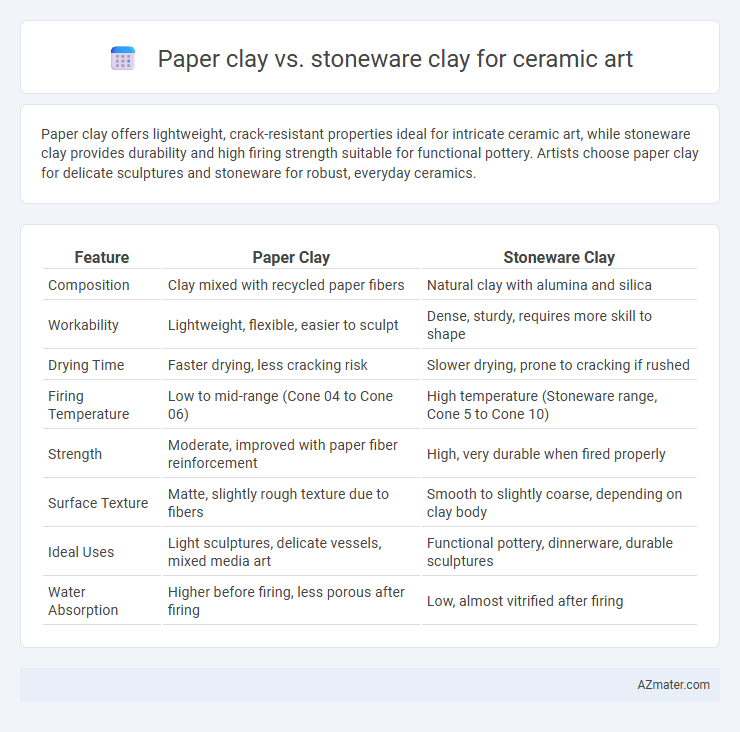Paper clay offers lightweight, crack-resistant properties ideal for intricate ceramic art, while stoneware clay provides durability and high firing strength suitable for functional pottery. Artists choose paper clay for delicate sculptures and stoneware for robust, everyday ceramics.
Table of Comparison
| Feature | Paper Clay | Stoneware Clay |
|---|---|---|
| Composition | Clay mixed with recycled paper fibers | Natural clay with alumina and silica |
| Workability | Lightweight, flexible, easier to sculpt | Dense, sturdy, requires more skill to shape |
| Drying Time | Faster drying, less cracking risk | Slower drying, prone to cracking if rushed |
| Firing Temperature | Low to mid-range (Cone 04 to Cone 06) | High temperature (Stoneware range, Cone 5 to Cone 10) |
| Strength | Moderate, improved with paper fiber reinforcement | High, very durable when fired properly |
| Surface Texture | Matte, slightly rough texture due to fibers | Smooth to slightly coarse, depending on clay body |
| Ideal Uses | Light sculptures, delicate vessels, mixed media art | Functional pottery, dinnerware, durable sculptures |
| Water Absorption | Higher before firing, less porous after firing | Low, almost vitrified after firing |
Introduction to Paper Clay and Stoneware Clay
Paper clay consists of natural clay mixed with cellulose fibers, enhancing its strength, flexibility, and drying properties, making it ideal for intricate ceramic art and hand-building techniques. Stoneware clay is a durable, vitrified clay fired at high temperatures, known for its stone-like hardness, resistance to chipping, and suitability for functional pottery and sculptural pieces. Both clays offer unique working and firing characteristics, with paper clay excelling in lightweight construction and stoneware clay providing robust, long-lasting results.
Composition and Material Differences
Paper clay contains cellulose fibers added to traditional clay bodies, enhancing its flexibility and reducing drying times, which prevents cracking during the forming process. Stoneware clay is a dense, iron-rich clay composed primarily of kaolin, feldspar, and silica, firing to a strong, vitrified state at high temperatures around 1200-1300degC. The fibrous composition of paper clay allows for thinner, lighter ceramic pieces, while stoneware clay offers durability and a robust texture suitable for functional pottery.
Workability and Sculpting Features
Paper clay offers superior workability compared to stoneware clay due to its lightweight composition and increased flexibility, allowing for easier manipulation and attachment of delicate parts. Stoneware clay, known for its dense and durable nature, provides excellent sculpting features for detailed, sturdy ceramic art but requires more skill to handle given its heavier texture and slower drying time. For artists focusing on intricate, lightweight sculptures, paper clay enhances creative possibilities, while stoneware clay is preferred for robust, long-lasting finished pieces.
Strength and Durability Comparison
Stoneware clay exhibits superior strength and durability compared to paper clay, which contains cellulose fibers to enhance workability but reduces overall structural toughness. Stoneware's high firing temperature typically results in a dense, vitrified body resistant to chipping and cracking, making it ideal for functional ceramic art. Paper clay, while lighter and easier to manipulate, generally possesses lower mechanical strength and is more susceptible to damage under stress after firing.
Firing Temperatures and Kiln Compatibility
Paper clay offers greater flexibility in firing temperatures, typically maturing between cone 04 to cone 6 (approximately 1940degF to 2232degF), making it compatible with a range of kiln types, including electric and gas. Stoneware clay generally requires higher firing temperatures, usually between cone 6 to cone 10 (2232degF to 2345degF), necessitating kilns that can consistently reach and maintain these hotter conditions for proper vitrification and strength. Choosing between paper clay and stoneware clay depends on the specific firing range and kiln capabilities available to the ceramic artist.
Surface Texture and Finish Quality
Paper clay offers a lighter, more porous surface texture compared to stoneware clay, allowing for easier manipulation and finer details in ceramic art. Stoneware clay delivers a dense, durable finish with a smooth, vitrified surface after firing, ideal for functional and high-strength pieces. The finish quality of paper clay remains matte and slightly textured, whereas stoneware clay achieves a glossy or satin finish depending on glazing and firing temperature.
Suitability for Hand-building and Wheel Throwing
Paper clay offers exceptional flexibility and lightweight properties, making it ideal for intricate hand-building techniques and delicate sculptural work. Stoneware clay possesses a denser, more plastic texture that suits wheel throwing, enabling the creation of durable and functional pottery with smooth surfaces. Artists often choose paper clay for detailed, lightweight forms and stoneware for robust, wheel-thrown vessels requiring high firing strength.
Repair and Joining Capabilities
Paper clay offers superior repair and joining capabilities due to its lightweight composition and enhanced flexibility, allowing easier attachment of wet and dry pieces without sagging. Stoneware clay, being denser and less porous, requires precise timing for joining and often benefits from scoring and slip to ensure strong bonds. Artists prefer paper clay for complex assemblies and intricate repairs, while stoneware clay is favored for durability and strength after firing.
Artistic Applications and Project Suitability
Paper clay offers enhanced flexibility and lightweight properties, making it ideal for intricate, delicate ceramic art and sculptural projects requiring fine detail. Stoneware clay, known for its durability and high firing temperature, suits functional pottery and robust art pieces that demand strength and longevity. Artists often prefer paper clay for experimental, mixed-media works, while stoneware is favored for traditional ceramics and everyday use items.
Choosing the Right Clay for Your Ceramic Art
Paper clay offers enhanced flexibility and lighter weight compared to stoneware clay, making it ideal for delicate, intricate ceramic art pieces that require fine detail and reduced shrinkage during drying. Stoneware clay boasts durability and high firing strength, producing robust, functional ceramics with a dense, vitrified finish suitable for both artistic and utilitarian works. Selecting the right clay depends on the desired texture, firing temperature (paper clay typically fires at cone 6, stoneware at cone 5-10), and final use, balancing workability against strength and aesthetic goals.

Infographic: Paper clay vs Stoneware clay for Ceramic art
 azmater.com
azmater.com